同步概念
- 所谓同步,即同时起步,协调一致。不同的对象,对“同步”的理解方式略有不同。如,设备同步,是指在两个设备之间规定一个共同的时间参考;数据库同步,是指让两个或多个数据库内容保持一致,或者按需要部分保持一致;文件同步,是指让两个或多个文件夹里的文件保持一致。等等
- 但是在编程中、通信中所说的同步与生活中大家印象中的同步概念略有差异。“同”字应是指协同、协助、互相配合。主旨在协同步调,按预定的先后次序运行。
线程同步
- 同步即协同步调,按预定的先后次序运行。
- 线程同步,指一个线程发出某一功能调用时,在没有得到结果之前,该调用不返回。同时其它线程为保证数据一致性,不能调用该功能。
- 举个例子: 内存中100字节,线程T1欲填入全1, 线程T2欲填入全0。但如果T1执行了50个字节后失去了cpu,T2抢到了cpu执行填入全0,会将T1写过的内容覆盖。当T1再次获得cpu继续 从失去cpu的位置向后写入1,当执行结束,内存中的100字节,既不是全1,也不是全0。这种现象叫做“与时间有关的错误”(time related)。为了避免这种数据混乱,线程需要同步。
- “同步” 的目的,是为了避免数据混乱,解决与时间有关的错误。实际上,不仅线程间需要同步,进程间、信号间等等都需要同步机制。
- 因此,所有“多个控制流,共同操作一个共享资源”的情况,都需要同步。
数据混乱原因:
- 资源共享(如果独享资源就不会产生这种情况)
- 调度随机(意味着数据访问会出现竞争)
- 线程间缺乏必要的同步机制。
以上3点中,前两点不能改变,欲提高效率,传递数据,资源必须共享。只要共享资源,就一定会出现竞争。只要存在竞争关系,数据就很容易出现混乱。
所以只能从第三点着手解决。使多个线程在访问共享资源的时候,出现互斥。
互斥量mutex
- Linux中提供一把互斥锁mutex(也称之为互斥量)。每个线程在对资源操作前都尝试先加锁,成功加锁才能操作,操作结束解锁。资源还是共享的,线程间也还是竞争的,但通过“锁”就将资源的访问变成互斥操作,而后与时间有关的错误也不会再产生了。

- 但应注意:同一时刻,只能有一个线程持有该锁。当A线程对某个全局变量加锁访问,B在访问前尝试加锁,拿不到锁,B阻塞。C线程不去加锁,而直接访问该全局变量,依然能够访问,但会出现数据混乱。
- 所以,互斥锁实质上是操作系统提供的一把“建议锁”(又称“协同锁”),建议程序中有多线程访问共享资源的时候使用该机制。但并没有强制限定。
- 因此,即使有了mutex,如果有线程不按规则来访问数据,依然会造成数据混乱。
主要应用函数:
pthread_mutex_init函数
pthread_mutex_destroy函数
pthread_mutex_lock函数
pthread_mutex_trylock函数
pthread_mutex_unlock函数
- 以上5个函数的返回值都是:成功返回0, 失败返回错误号。
- pthread_mutex_t 类型,其本质是一个结构体。为简化理解,应用时可忽略其实现细节,简单当成整数看待。
- pthread_mutex_t mutex; 变量mutex只有两种取值1、0。
pthread_mutex_init 函数:初始化一个互斥锁(互斥量) ,初值可看作1
int pthread_mutex_init(pthread_mutex_t *restrict mutex, const pthread_mutexattr_t *restrict attr);
1. 参1:传出参数,调用时应传 &mutex
2. estrict关键字:只用于限制指针,告诉编译器,所有修改该指针指向内存中内容的操作,只能通过本指针完成。不能通过除本指针以外的其他变量或指针修改
3. 参2:互斥量属性。是一个传入参数,通常传NULL,选用默认属性(线程间共享)。
- 静态初始化:如果互斥锁 mutex 是静态分配的(定义在全局,或加了static关键字修饰),可以直接使用宏进行初始化。
例如:pthead_mutex_t muetx = PTHREAD_MUTEX_INITIALIZER
- 动态初始化:局部变量应采用动态初始化。
例如:pthread_mutex_init(&mutex, NULL)
pthread_mutex_destroy函数 销毁一个互斥锁
int pthread_mutex_destroy(pthread_mutex_t *mutex);
pthread_mutex_lock函数 加锁。
- 可理解为将mutex–(或-1)
int pthread_mutex_lock(pthread_mutex_t *mutex);
pthread_mutex_unlock函数 解锁。
- 可理解为将mutex ++(或+1)
int pthread_mutex_unlock(pthread_mutex_t *mutex);
pthread_mutex_trylock函数 尝试加锁
int pthread_mutex_trylock(pthread_mutex_t *mutex);
区别(lock与unlock)(lock和trylock)
- lock尝试加锁,如果加锁不成功,线程阻塞,阻塞到持有该互斥量的其他线程解锁为止。
- unlock 主动解锁函数,同时将阻塞在该锁上的所有线程全部唤醒,至于哪个线程先被唤醒,取决于优先级、调度。默认:先阻塞的线程、先被唤醒。
例如:T1 T2 T3 T4 使用一把mutex锁。T1加锁成功,其他线程均阻塞,直至T1解锁。T1解锁后,T2 T3 T4均被唤醒,并自动再次尝试加锁。
- 可假想mutex锁 init 成功初值为1。lock 功能是将mutex- -。 unlock将mutex++
- lock与trylock:
- lock加锁失败会阻塞,等待锁释放。
- trylock加锁失败直接返回错误号(如:EBUSY),不阻塞。
代码:未加锁的程序
1 #include
2 #include
3 #include
4
5 void *tfn(void *arg)
6 {
7 srand(time(NULL));
8 while (1) {
9
10 printf("hello ");
11 sleep(rand() % 3); /*模拟长时间操作共享资源,导致cpu易主,产生与时间有关的错误*/
12 printf("world\n");
13 sleep(rand() % 3);
14 }
15 return NULL;
16 }
17 int main(void)
18 {
19 pthread_t tid;
20 srand(time(NULL));
21 pthread_create(&tid, NULL, tfn, NULL);
22 while (1) {
23 printf("HELLO ");
24 sleep(rand() % 3);
25 printf("WORLD\n");
26 sleep(rand() % 3);
27 }
28 pthread_join(tid, NULL);
29 return 0;
30 }

- 我们会发现在上面的程序中,由于我们没有加锁,当一个线程执行的时候,可能会失去cpu,导致自身的工作挂起,而去执行另外的线程。会出现如上输出的乱序。
- 但是如果加锁,就不会出现这种情况。
1 #include
2 #include
3 #include
4
5 pthread_mutex_t mutex;
6
7 void *tfn(void *arg)
8 {
9 srand(time(NULL));
10 while (1) {
11 pthread_mutex_lock(&mutex);
12 printf("hello ");
13 sleep(rand() % 3); /*模拟长时间操作共享资源,导致cpu易主,产生与时间有关的错误*/
14 printf("world\n");
15 pthread_mutex_unlock(&mutex);
16 sleep(rand() % 3);
17 }
18 return NULL;
19 }
20 int main(void)
21 {
22 pthread_t tid;
23 srand(time(NULL));
24 pthread_mutex_init(&mutex,NULL);
25 pthread_create(&tid, NULL, tfn, NULL);
26 while (1) {
27 pthread_mutex_lock(&mutex);
28 printf("HELLO ");
29 sleep(rand() % 3);
30 printf("WORLD\n");
31 pthread_mutex_unlock(&mutex);
32 sleep(rand() % 3);
33 }
34 pthread_join(tid, NULL);
35 pthread_mutex_destroy(&mutex);
36 return 0;
37 }

- 在访问共享资源前加锁,访问结束后立即解锁。锁的“粒度”应越小越好。
死锁
- 线程试图对同一个互斥量A加锁两次。
- 线程1拥有A锁,请求获得B锁;线程2拥有B锁,请求获得A锁
1 #include
2 #include
3
4 pthread_mutex_t mutex;
5
6 int main()
7 {
8 int a = 100;
9
10 pthread_mutex_init(&mutex,NULL);
11 pthread_mutex_lock(&mutex);
12 pthread_mutex_lock(&mutex);
13 a = 200;
14 pthread_mutex_unlock(&mutex);
15 pthread_mutex_destroy(&mutex);
16 return 0;
17 }
1 #include
2 #include
3 #include
4 #include
5 #include
6
7 pthread_mutex_t mutex1,mutex2;
8 int a = 100, b = 100;
9
10 void* sfn(void* arg)
11 {
12 int count = *(int*)arg;
13 if(count == 1)
14 {
15 pthread_mutex_lock(&mutex1);
16 a = 200;
17 printf("aaaaaaaaaaaa1\n");
18 sleep(5); //为了让另外一个线程拿到cpu
19 printf("aaaaaaaaaaa2\n");
20 pthread_mutex_lock(&mutex2);
21 b = 200;
22 pthread_mutex_unlock(&mutex2);
23 pthread_mutex_unlock(&mutex1);
24
25 printf("thread finish %d\n",count);
26 pthread_exit(NULL);
27 }
28 if(count == 2)
29 {
30 printf("bbbbbbbbbbbb\n");
31 pthread_mutex_lock(&mutex2);
32 a = 300;
33 pthread_mutex_lock(&mutex1);
34 b = 300;
35 pthread_mutex_unlock(&mutex1);
36 pthread_mutex_unlock(&mutex2);
37
38 printf("thread finish %d\n",count);
39 pthread_exit(NULL);
40 }
41 return NULL;
42 }
43
44 int main()
45 {
46 pthread_t tid1,tid2;
47 int ret;
48
49 pthread_mutex_init(&mutex1,NULL);
50 pthread_mutex_init(&mutex2,NULL);
51
52 int argument1 = 1;
53 int* p1 = &argument1;
54 ret = pthread_create(&tid1,NULL,sfn,(void*)p1);
55 if(ret != 0)
56 {
57 fprintf(stderr,"pthread create error : %lu\n",strerror(ret));
58 exit(0);
59 }
60 int argument2 = 2;
61 int *p2 = &argument2;
62 ret = pthread_create(&tid2,NULL,sfn,(void*)p2);
63 if(ret != 0)
64 {
65 fprintf(stderr,"pthread create error : %lu\n",strerror(ret));
66 exit(1);
67 }
68
69 sleep(100); // 为了不让主线程在子线程之前退出
70 pthread_mutex_destroy(&mutex1);
71 pthread_mutex_destroy(&mutex2);
72
73 pthread_join(tid1,NULL);
74 pthread_join(tid2,NULL);
75
76 printf("last val a = %d, b = %d\n",a,b);
77 return 0;
78 }
- 这就像我拿了一个钻石,你拿了黄金,我说,你先把黄金给我,我在把钻石给你;你说你先把钻石给我,我在把黄金给你。然后我们两个就在这里耗着,一直在耗着。。。
读写锁
- 与互斥量类似,但读写锁允许更高的并行性。其特性为:写独占,读共享。
- 读写锁状态:
- 一把读写锁具备三种状态:
- 读模式下加锁状态 (读锁)
- 写模式下加锁状态 (写锁)
- 不加锁状态
- 读写锁特性:
- 读写锁是“写模式加锁”时, 解锁前,所有对该锁加锁的线程都会被阻塞。
- 读写锁是“读模式加锁”时, 如果线程以读模式对其加锁会成功;如果线程以写模式加锁会阻塞。
- 读写锁是“读模式加锁”时, 既有试图以写模式加锁的线程,也有试图以读模式加锁的线程。那么读写锁会阻塞随后的读模式锁请求。优先满足写模式锁。读锁、写锁并行阻塞,写锁优先级高
- 读写锁也叫共享-独占锁。当读写锁以读模式锁住时,它是以共享模式锁住的;当它以写模式锁住时,它是以独占模式锁住的。写独占、读共享。
- 读写锁非常适合于对数据结构读的次数远大于写的情况。
主要应用函数:
pthread_rwlock_init函数
pthread_rwlock_destroy函数
pthread_rwlock_rdlock函数
pthread_rwlock_wrlock函数
pthread_rwlock_tryrdlock函数
pthread_rwlock_trywrlock函数
pthread_rwlock_unlock函数
- 以上7 个函数的返回值都是:成功返回0, 失败直接返回错误号。
- pthread_rwlock_t类型 用于定义一个读写锁变量。
pthread_rwlock_t rwlock;
- pthread_rwlock_init函数,初始化一把读写锁
int pthread_rwlock_init(pthread_rwlock_t *restrict rwlock, const pthread_rwlockattr_t *restrict attr);
参1:读写锁 rwlock,加上 restrict 关键字表示这块内存空间只能由rwlock这个指针访问。
参2:attr表读写锁属性,通常使用默认属性,传NULL即可。
- pthread_rwlock_destroy函数,销毁一把读写锁
int pthread_rwlock_destroy(pthread_rwlock_t *rwlock);
- pthread_rwlock_rdlock函数,以读方式请求读写锁。(常简称为:请求读锁)
int pthread_rwlock_rdlock(pthread_rwlock_t *rwlock);
- pthread_rwlock_wrlock函数,以写方式请求读写锁。(常简称为:请求写锁)
int pthread_rwlock_wrlock(pthread_rwlock_t *rwlock);
- pthread_rwlock_unlock函数,解锁
int pthread_rwlock_unlock(pthread_rwlock_t *rwlock);
- pthread_rwlock_tryrdlock函数,非阻塞以读方式请求读写锁(非阻塞请求读锁)
int pthread_rwlock_tryrdlock(pthread_rwlock_t *rwlock);
- pthread_rwlock_trywrlock函数,非阻塞以写方式请求读写锁(非阻塞请求写锁)
int pthread_rwlock_trywrlock(pthread_rwlock_t *rwlock);
读写锁代码
1 #include
2 #include
3 #include
4
5 int counter;
6 pthread_rwlock_t rwlock;
7
8 /* 3个线程不定时写同一全局资源,5个线程不定时读同一全局资源 */
9 void *th_write(void *arg)
10 {
11 int t, i = (int)arg;
12 while (1) {
13 pthread_rwlock_wrlock(&rwlock);
14 t = counter;
15 usleep(1000);
16 printf("=======write %d: %lu: counter=%d ++counter=%d\n", i, pthread_self(), t, ++counter);
17 pthread_rwlock_unlock(&rwlock);
18 usleep(10000);
19 }
20 return NULL;
21 }
22 void *th_read(void *arg)
23 {
24 int i = (int)arg;
25
26 while (1) {
27 pthread_rwlock_rdlock(&rwlock);
28 printf("----------------------------read %d: %lu: %d\n", i, pthread_self(), counter);
29 pthread_rwlock_unlock(&rwlock);
30 usleep(2000);
31 }
32 return NULL;
33 }
34 int main(void)
35 {
36 int i;
37 pthread_t tid[8];
38 pthread_rwlock_init(&rwlock, NULL);
39
40 for (i = 0; i < 3; i++)
41 pthread_create(&tid[i], NULL, th_write, (void *)i);
42 for (i = 0; i < 5; i++)
43 pthread_create(&tid[i+3], NULL, th_read, (void *)i);
44 for (i = 0; i < 8; i++)
45 pthread_join(tid[i], NULL);
46
47 pthread_rwlock_destroy(&rwlock);
48 return 0;
49 }

- 我们可以看到一个线程对资源加了读锁时,别的线程还可以对该资源加读锁。但是如果一个线程对资源加了写锁时,别的线程就不能再给此资源进行加写锁了。所以我们可以看到上图中写锁基本上是一个出现,而读锁可以一大堆同时出现。



